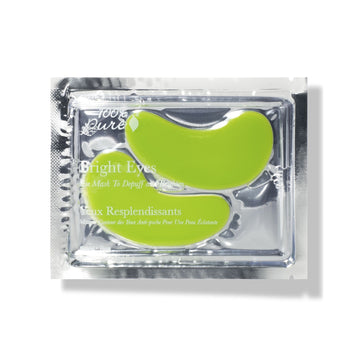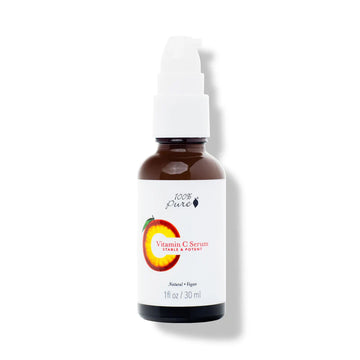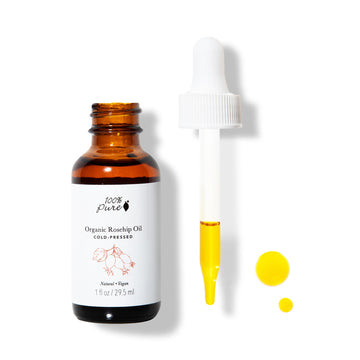A Science-Backed Guide to Treating and Minimizing Under-Eye Puffiness
Posted on April 19, 2025 Written by: 100% PURE®
Let’s be real—eye bags can be stubborn. Whether it’s puffiness, dark circles, or that tired look that won’t go away, not all under-eye concerns are the same, and treating them isn’t one-size-fits-all either.
In this guide, we’re breaking down the real reasons behind eye bags, clearing up some common myths, and sharing science-backed skincare tips that actually work. Ready to refresh those eyes? Let’s dive in.
Understanding Eye Bags
Ever wonder why eye bags seem to show up out of nowhere—or why they stick around even after a good night’s sleep? The truth is, under-eye puffiness isn’t just about being tired. It’s tied to a mix of anatomy, genetics, lifestyle, and even health conditions.
Eye bags are the mild swelling or puffiness that forms under the eyes, often paired with a bit of shadow or discoloration. Sometimes they're temporary—caused by things like fluid retention, allergies, or a salty dinner. But in other cases, they’re more persistent due to fat shifting or skin aging.
The skin beneath your eyes is naturally thinner and more delicate than the rest of your face. It also has fewer oil glands and minimal fat padding, which makes it especially prone to showing signs of stress, aging, and circulation issues. As a result, blood vessels and underlying structures become more visible, contributing to a puffy or tired appearance.
Primary Causes
Genetics: Some people are simply predisposed to under-eye puffiness or dark circles.
Aging: Over time, skin loses collagen and elasticity, and fat can shift downward, creating sagging.
Lifestyle: Lack of sleep, salty foods, allergies, alcohol, and smoking can all make eye bags worse.
Health Conditions: Issues like thyroid imbalance, kidney problems, or chronic sinus congestion can cause or intensify swelling.
Debunking Common Eye Bag Myths
Eye bags are often misunderstood, and there's a lot of hype out there. Here’s what’s fact and what’s fiction when it comes to treating and understanding under-eye puffiness:
Myth: Eye creams eliminate eye bags permanently
Not quite. While a good eye cream can reduce puffiness, hydrate, and improve skin texture, it won’t permanently remove bags caused by fat displacement or aging. For those, structural interventions (like fillers or surgery) are often the only lasting fix.
Myth: Drinking water cures eye bags
Staying hydrated does help minimize puffiness, especially if dehydration is a trigger—but it’s not a magic solution. Diet, allergies, and genetics also play a role.
Myth: More sleep = no eye bags
Getting enough sleep helps, but it’s not just about hours. Quality sleep and how you sleep (like elevating your head) matter more. Poor sleep posture can actually make fluid pool under your eyes.
Myth: Eye bags are a sign of illness
Most of the time, eye bags are a cosmetic concern—not a medical one. Unless they appear suddenly with other symptoms, they’re rarely linked to serious health issues.
The bottom line? Don’t fall for the quick-fix myths. Understanding your unique under-eye anatomy and causes will lead to more effective, long-term solutions.
A Skincare Routine That Actually Works
When it comes to eye bags, consistency is key—and using the right products in the right way can make a noticeable difference. Here’s a simple yet powerful routine to help you refresh and revive your under-eye area, morning and night.
Morning Routine
1. Cleanse Gently
Use lukewarm water and a soft touch—no rubbing or tugging.
Choose a fragrance-free, non-stripping cleanser to keep the delicate eye area calm.
2. Treat with Eye-Specific Actives
Look for ingredients like caffeine (to de-puff), peptides (for firmness), vitamin C (to brighten), and hyaluronic acid (for hydration).
Recommended products:
100% PURE Bright Eyes Masks– Instantly hydrates and soothes puffiness.
100% PURE Multi-Vitamin + Antioxidants PM Eye Treatment– A peptide-rich powerhouse to support elasticity.
3. Apply a Vitamin C Serum
Helps fade dark circles and supports collagen.
Recommended product:
100% PURE Vitamin C Serum– A gentle, brightening boost for tired eyes.
4. Moisturize & Protect
Use a lightweight, non-irritating SPF to shield the under-eye from UV damage (yes, even here!).
Evening Routine
1. Remove Makeup Carefully
Use oil-based or micellar water to gently dissolve makeup—no rubbing needed.
2. Apply Repairing Treatments
Target nighttime repair with niacinamide, peptides, and gentle retinoids.
Recommended products:
100% PURE Niacinamide Boost– Brightens, calms, and fortifies.
100% PURE Multi-Vitamin + Antioxidants PM Eye Treatment– For overnight renewal.
3. Moisturize Strategically
Pick a rich but non-migrating eye cream and apply it 30–40 minutes before bed so it stays put.
Sleep with your head slightly elevated to prevent overnight puffiness.
Weekly Treatments
1. Cooling Eye Masks
Store them in the fridge—cooling helps reduce inflammation and puffiness fast.
2. Gentle Lymphatic Drainage Massage
Use your ring fingers to lightly press and sweep from the inner corner outward.
This helps move fluid and stimulates circulation.
Stick with this routine and pair it with good sleep, hydration, and stress management—and you’ll be well on your way to brighter, smoother, more refreshed eyes.
Ingredients That Actually Help with Eye Bags
Not all skincare ingredients are created equal—especially when it comes to the delicate under-eye area. The right actives can visibly reduce puffiness, brighten dark circles, and strengthen your skin over time. Here are the proven power players you’ll want in your routine:
Caffeine: A go-to for de-puffing, caffeine constricts blood vessels and reduces fluid buildup, making eyes look more awake.
Vitamin C: This brightening antioxidant helps even out skin tone and supports collagen for firmer, fresher-looking skin.
Peptides: These tiny proteins boost elasticity, support skin repair, and help reduce fine lines and sagging.
Niacinamide: A multitasker—it calms irritation, strengthens the skin barrier, and reduces discoloration and puffiness.
Vitamin K: Thought to improve blood flow and reduce the look of dark circles over time.
Jojoba Oil or Rosehip Oil: Lightweight yet nourishing, these oils hydrate and repair without clogging pores.
Recommended product:
100% PURE Organic Rosehip Oil– Packed with essential fatty acids and antioxidants, it deeply nourishes and supports the delicate under-eye area. Perfect for soothing and restoring tired skin.

When to Consider Professional Treatments
If at-home skincare isn’t cutting it and puffiness persists, it might be time to explore professional treatments. A dermatologist can guide you through options like:
Laser Therapy: Targets pigmentation and stimulates collagen production to reduce puffiness and dark circles.
Injectable Fillers: Fillers can restore volume lost with aging and smooth out hollow areas under the eyes.
Blepharoplasty (Eyelid Surgery): A more permanent solution for removing excess skin or fat that contributes to bags.
Medical-Grade Peels: Chemical peels can exfoliate and rejuvenate the skin, improving texture and reducing dark circles.
Lifestyle Shifts That Complement Your Skincare
In addition to your skincare routine, small lifestyle changes can make a big difference in reducing under-eye puffiness:
Sleep Position: Elevating your head while sleeping prevents fluid from pooling under your eyes.
Limit Salt and Alcohol: Both can lead to water retention and worsen puffiness.
Manage Allergies: Use antihistamines or allergy treatments to prevent swelling triggered by allergens.
Stay Hydrated: Drinking enough water helps flush out toxins and reduces puffiness.
Adopt an Anti-Inflammatory Diet: Eating foods rich in leafy greens, berries, and omega-3s can reduce inflammation and promote healthy skin.
Effective Solutions for Eye Bags
Eye bags can be tough to tackle, but with consistent skincare and lifestyle changes, real improvement is possible. Focus on hydration, collagen support, and circulation with ingredients like vitamin C, peptides, caffeine, and niacinamide. 100% PURE’s natural formulations provide gentle yet effective support for reducing puffiness and discoloration under the eyes.
Frequently Asked Questions (FAQs)
What causes eye bags and are they permanent?
Eye bags can be caused by factors like genetics, aging, fluid retention, or lifestyle habits (such as lack of sleep). While some causes like aging or genetics may not be completely reversible, consistent skincare and lifestyle adjustments can significantly reduce puffiness and improve the appearance of the under-eye area.
Can vitamin C serum really help reduce under-eye puffiness?
Yes! Vitamin C helps brighten dark circles and supports collagen production, which can firm and strengthen the skin under your eyes. While it doesn’t directly target puffiness, it improves skin health and appearance, helping your under-eye area look fresher.
How do I know if my eye bags are genetic or lifestyle-related?
If you’ve had persistent puffiness or dark circles from a young age, they may be genetic. However, if they've appeared recently or worsened with poor sleep, diet, or stress, they're more likely lifestyle-related. A dermatologist can help determine the cause and offer tailored advice.
What’s the best way to apply eye cream for maximum absorption?
Gently tap the cream around your under-eye area using your ring fingers, as they apply the least pressure. Avoid rubbing or tugging the skin. Apply in small amounts and use a light patting motion to promote absorption and encourage circulation.
How often should I use eye masks to see results?
Eye masks can be used 2–3 times a week for optimal results. For more persistent puffiness or dark circles, you may use them more frequently but always follow the instructions on the product for best results.
- Tags: April-2025
We carefully hand-select products based on strict purity standards, and only recommend products we feel meet this criteria. 100% PURE™ may earn a small commission for products purchased through affiliate links.
The information in this article is for educational use, and not intended to substitute professional medical advice, diagnosis, or treatment and should not be used as such.



















